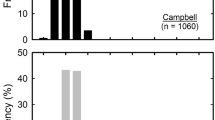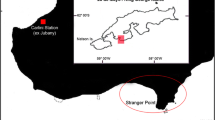Abstract.
The food of three closely related and sympatric species of mollymawks (Diomedea spp.), the black-browed (BBA, D. melanophrys), grey-headed (GHA, D. chrysostoma) and yellow-nosed (YNA, D. chlororhynchos) albatrosses, was compared at Iles Nuageuses, Kerguelen, during the chick-rearing period. BBA preyed almost equally upon cephalopods (39% by fresh mass), fish (31%) and penguins (31%), while GHA fed more on squids (52%, 16% and 28%, respectively) and YNA fed more on fish and not on penguins (13%, 84% and 0%, respectively). Crustaceans were always a minor component of the diet (<3%). Patagonian toothfish was the main fish prey, and Todarodes sp. the main cephalopod prey for the community. Accumulated beaks emphasise the importance of juvenile ommastrephid squids in the diet of mollymawks, accounting for 81%, 71% and 55% of the total number of beaks in BBA, GHA and YNA samples, respectively. BBA preyed also upon a significant number of the octopod Benthoctopus thielei (12%) and of the cranchiid squid Galiteuthis glacialis (4%), while GHA fed more on G. glacialis (18%) and on the onychoteuthid Kondakovia longimana (8%). When feeding on the same prey, prey size was similar for the albatross species. Comparison of overall prey biogeography together with the presence/absence of prey species indicators of water masses indicates segregation through different foraging areas among the three mollymawks. BBA forage almost exclusively over the shelf and upper slope waters surrounding the Kerguelen Archipelago. By contrast, GHA and YNA feed mainly in oceanic waters, YNA favouring the warm subtropical waters, and GHA the cold Antarctic waters. It is thus remarkable that birds from the same breeding grounds forage over such a wide latitudinal range, from about 35–40°S to 60–65°S, encompassing the Subtropical Zone for YNA, the Antarctic Zone for GHA and the Antarctic Polar Frontal Zone (where Kerguelen is located) for the three species.
Similar content being viewed by others
Author information
Authors and Affiliations
Additional information
Electronic Publication
Rights and permissions
About this article
Cite this article
Cherel, .Y., Weimerskirch, .H. & Trouvé, .C. Dietary evidence for spatial foraging segregation in sympatric albatrosses (Diomedea spp.) rearing chicks at Iles Nuageuses, Kerguelen. Marine Biology 141, 1117–1129 (2002). https://doi.org/10.1007/s00227-002-0907-5
Received:
Accepted:
Issue Date:
DOI: https://doi.org/10.1007/s00227-002-0907-5




